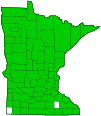curlytop knotweed
(Persicaria lapathifolia)
Conservation • Wetland • Description • Habitat • Ecology • Use • Distribution • Taxonomy
Conservation Status |
|||
| IUCN Red List | LC - Least Concern |
||
| NatureServe | N5 - Secure SNR - Unranked |
||
| Minnesota | not listed |
||
Wetland Indicator Status |
|
||
| Great Plains | OBL - Obligate wetland |
||
| Midwest | FACW - Facultative wetland |
||
| Northcentral & Northeast | FACW - Facultative wetland |
||
Description |
Curlytop knotweed, also called pale smartweed, is a 24″ to 60″ tall, erect, annual forb that rises from a taproot and shallow, fibrous roots. The stems are ascending to erect, occasionally branched, round, and hairless. They are conspicuously swollen at the leaf nodes.The Latin word polygonum is derived from Greek and means "many knees or joints", referring to the swollen nodes. The leaves are alternate, variable in shape but usually lance-shaped, 1½″ to 4¾″ long, and 3 ⁄16″ to 1½″ wide. They are on leaf stalks up to ⅝″ long. The leaf stalks wrap around the stem with a membranous sheath (ocrea) at the base. The ocrea is hairless and does not have a fringe of hairs or bristles on the margin. It turns brown as the leaf matures and eventually peels away. The leaf blades are tapered or wedge-shaped at the base and taper to a point at the tip with concave sides along the tip. The upper surface is hairless. The lower surface is usually hairless, sometimes covered with short, soft, woolly hairs, especially when young. The margins are untoothed. There is sometimes a dark blotch in the middle of the leaf blade, but it is neither as common nor as prominent as with spotted lady’s thumb. The inflorescence is an unbranched, spike-like cluster (raceme) at the end of the stem and branches and sometimes also rising from the upper leaf axils. The racemes are arching or nodding, robust, dense, 1¼″ to 3⅛″ long, and 3 ⁄16″ to ½″ wide. They are usually not interrupted. The flowers are arranged in several bundles (fascicles) with 4 to 14 flowers each. The fascicles are sheathed at the base and the sheaths overlap. Individual flowers are 1 ⁄16″ to ⅛″ long. There are 5 sepals and no petals (5 tepals). The tepals are fused at the base. The outer 2 or 3 tepals are egg-shaped to elliptic, usually greenish-white, sometimes pink, with prominent, anchor-shaped veins. There are 5 or 6 stamens and 2 or 3 styles. The stamens have pink or red anthers. The styles are fused at the base. The flowers rarely open, so the stamens, styles, and inner tepals are difficult to see. There is no fragrance. The fruit is dark brown to black, oval, 1 ⁄16″ to ⅛″ wide achene. The achene is flattened or concave on both sides. |
Height |
24″ to 60″ |
Flower Color |
Greenish-white to pink |
Similar Species |
Pennsylvania smartweed (Persicaria pensylvanica) racemes are mostly held erect, rarely nodding. The flowers are often pink. Spotted lady’s thumb (Persicaria maculosa) is a smaller plant, no more than 32″ in height. The ocrea has a few short hairs on the margin. There is usually a prominent, dark blotch in the middle of the leaf blade. The flowers are pink to rose. |
Habitat |
Wet to moist. Lake shores, pond edges, marshes, wet prairies, ditches, railroads, roadsides, gravel bars, disturbed sites. Full to partial sun. |
Ecology |
Flowering |
July to September |
Pests and Diseases |
|
Use |
|
Distribution |
||
|
Sources Biodiversity occurrence data published by: Minnesota Biodiversity Atlas (accessed through the Minnesota Biodiversity Atlas Portal, bellatlas.umn.edu,9/6/2025). |
|
| 9/6/2025 | ||
Nativity |
||
| Native | ||
Occurrence |
||
Common |
||
Taxonomy |
|
Kingdom |
|
Division |
Tracheophyta (Vascular Plants) |
Subdivision |
Spermatophytina (Seed Plants) |
Class |
|
Superorder |
Caryophyllanae |
Order |
Caryophyllales (Pinks, Cactuses, and Allies) |
Family |
Polygonaceae (knotweed) |
Subfamily |
Polygonoideae |
Tribe |
Persicarieae |
Subtribe |
Persicariinae |
Genus |
Persicaria (knotweeds, smartweeds, and waterpeppers) |
Subordinate Taxa |
|
More than 24 subspecies, varieties, or forms (infraspecific taxa) of Persicaria lapathifolia have been described. However, most do not recognize any infraspecific taxa. |
|
Synonyms |
|
Persicaria incarnata Persicaria tomentosa Polygonum incanum Polygonum incarnatum Polygonum lapathifolium Polygonum lapathifolium var. incanum Polygonum lapathifolium var. nodosum Polygonum lapathifolium var. ovatum Polygonum lapathifolium ssp. pallidum Polygonum lapathifolium var. prostratum Polygonum lapathifolium var. salicifolium Polygonum nodosum Polygonum oneillii Polygonum pensylvanicum ssp. oneillii Polygonum scabrum Polygonum tomentosum |
|
Common Names |
|
curltop ladysthumb curlytop knotweed curlytop smartweed dock-leaf smartweed dock-leaved smartweed heart’s-ease nodding smartweed pale persicaria pale smartweed smartweed willow weed |
|
Glossary
Achene
A dry, one-chambered, single-seeded seed capsule, formed from a single carpel, with the seed attached to the membranous outer layer (wall) only by the seed stalk; the wall, formed entirely from the wall of the superior ovary, does not split open at maturity, but relies on decay or predation to release the contents.
Axil
The upper angle where a branch, stem, leaf stalk, or vein diverges.
Fascicle
A small bundle or cluster, often sheathed at the base, as with pine needles.
Node
The small swelling of the stem from which one or more leaves, branches, or buds originate.
Ocrea
A sheath around the stem at the base of a petiole formed from the stipules; a feature of many members of the Polygonaceae.
Petiole
On plants: The stalk of a leaf blade or a compound leaf that attaches it to the stem. On ants and wasps: The constricted first one or two segments of the rear part of the body.
Raceme
An unbranched, elongated inflorescence with stalked flowers. The flowers mature from the bottom up.
Sepal
An outer floral leaf, usually green but sometimes colored, at the base of a flower.
Sheath
The lower part of the leaf that surrounds the stem.
Stipule
A small, leaf-like, scale-like, glandular, or rarely spiny appendage found at the base of a leaf stalk, usually occurring in pairs and usually dropping soon.
Tepal
Refers to both the petals and the sepals of a flower when they are similar in appearance and difficult to tell apart. Tepals are common in lilies and tulips.
Visitor Photos
Share your photo of this plant.
This button not working for you?
Simply email us at info@MinnesotaSeasons.com.
Attach one or more photos and, if you like, a caption.
Amy D |
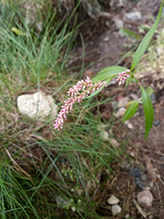 |
Luciearl |
||
 |
||
Bill Reynolds |
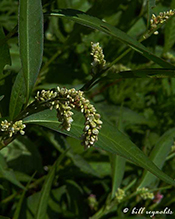 |
MinnesotaSeasons.com Photos
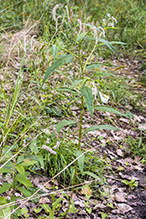 |
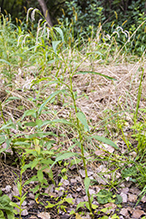 |
|
Plant |
Plant |
|
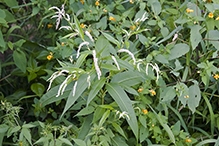 |
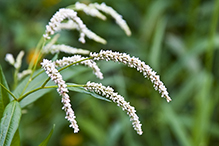 |
|
Inflorescence |
Inflorescence |
|
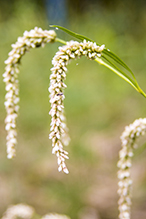 |
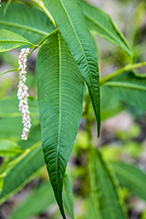 |
|
Inflorescence |
Leaves |
|
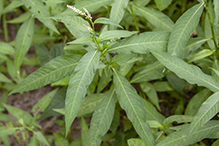 |
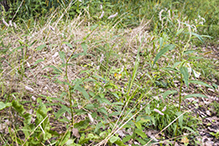 |
|
Leaves |
Compare Pennsylvania smartweed on the left with curlytop knotweed on the right |

Slideshows
Persicaria lapathifolia (Nodding Smartweed)
Allen Chartier

Visitor Videos
Share your video of this plant.
This button not working for you?
Simply email us at info@MinnesotaSeasons.com.
Attach a video, a YouTube link, or a cloud storage link.
Other Videos
Pale Persicaria (Persicaria Lapathifolia L.) - 2012-09-02
W3stlander
European Honeybee on Persicaria セイヨウミツバチ♀がオオイヌタデを訪花採餌
sigma1920HD
Curlytop Knotweed, オオイヌタデ
Koji Kimura

Visitor Sightings
Report a sighting of this plant.
This button not working for you?
Simply email us at info@MinnesotaSeasons.com.
Be sure to include a location.

